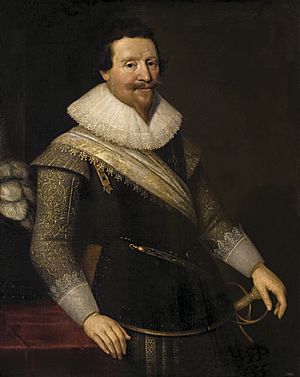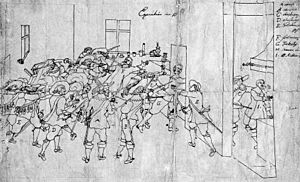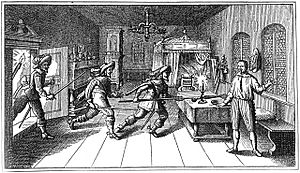Assassination of Wallenstein facts for kids
The Assassination of Wallenstein was a big event during the Thirty Years' War. On February 25, 1634, a group of Irish and Scottish officers killed Albrecht von Wallenstein, a very powerful general, and his companions. This happened in the town of Eger (which is now Cheb in the Czech Republic). These officers were acting with the approval of Ferdinand II, Holy Roman Emperor. The emperor rewarded the assassins and took property from the families of those who were killed. This event was part of a larger cleanup within the army of the Holy Roman Empire. Many other high-ranking officers who supported Wallenstein were also punished.
Contents
Who Was Wallenstein?
Albrecht von Wallenstein was born on September 24, 1584. He came from a noble family in Bohemia. He studied at the University of Altdorf but was soon expelled for fighting. For the next few years, he traveled around Europe. In 1604, he joined the army of the Holy Roman Empire. He fought in the Long Turkish War and became a colonel. He also commanded a unit during the Bocskai uprising.
In 1607, Wallenstein became a special assistant to Ferdinand of Styria. Ferdinand later became Ferdinand II, Holy Roman Emperor. In 1609, Wallenstein married Lucretia Vičkov, a wealthy widow. She died in 1614, and Wallenstein inherited her property. He also became very rich by changing his religion from Protestant to Catholic. This happened during a time when Bohemia was trying to bring back Catholicism.
Wallenstein's Rise to Power
When the Bohemian Revolt started in 1618, Wallenstein showed his loyalty to the emperor. He fought against his former Protestant friends. He even used his own money to hire soldiers. These soldiers helped win the important Battle of White Mountain. This battle ended the revolt in favor of the emperor.
In 1623, Wallenstein married Elizabeth von Harrach. Her father, Karl von Harrach, was an important advisor to Emperor Ferdinand. Wallenstein's new family connections and his wealth helped him a lot. He bought huge estates that used to belong to rebel nobles. He also loaned a lot of money to the emperor. This allowed him to raise thousands of troops.
Wallenstein fought many battles during the Thirty Years' War. He pushed back attacks by Gabriel Bethlen, who wanted to be the king of Hungary. He also defeated an army in the Palatinate campaign in 1623. After that, he won against the Danes between 1626 and 1628. These victories ended Denmark's involvement in the war.
By 1628, Wallenstein had become incredibly powerful. He even forgave a huge debt the emperor owed him. In return, he became an imperial prince and received the Duchy of Mecklenburg. His army was now three times larger than the Catholic League's army, which was the emperor's main ally. Wallenstein's quick rise to power made many people nervous. Members of the Catholic League worried that their own lands might be taken if they didn't obey the emperor.
Why Wallenstein Lost Favor
In July 1630, the Catholic League asked Emperor Ferdinand to fire Wallenstein. Wallenstein didn't like spending time at court. This allowed his enemies to spread false rumors about him. They even said he wanted to become emperor himself. The Spanish part of the Habsburg court was also angry because he didn't help them in the Eighty Years' War.
Because of all this pressure, Ferdinand fired Wallenstein on August 13. However, later that year, Sweden joined the war. This changed the balance of power against the empire. Many people still believed Wallenstein was the only general who could handle the situation. So, on April 13, 1632, he was brought back as general.
Wallenstein spent most of the next year campaigning. He often worked separately from his senior officers. Many officers avoided him because he was known for his angry outbursts. Some of his opponents in the army started sending secret messages. They criticized his slow approach and the lack of chances for promotion. Emperor Ferdinand found Wallenstein's answers to criticism unsatisfactory. They also disagreed on many things. For example, Wallenstein let a captured Protestant general, Jindřich Matyáš Thurn, go without permission. He also refused to attack during the winter months.
The Plot Against Wallenstein
Wallenstein faced more and more criticism. People were unhappy with his slow response to Swedish attacks in Bavaria. They also worried about Lorraine falling to the French. Wallenstein disliked court life, and the church had a lot of influence over the emperor. This created a secret group of enemies who started a whispering campaign against him.
On January 11, 1634, Gundakar, Prince of Liechtenstein officially asked Ferdinand II to get rid of Wallenstein. The very next day, Wallenstein asked his colonels to sign a paper called the First Pilsner Reverse. This paper declared their personal loyalty to him. Forty-nine officers signed it right away. Others gathered signatures in different regions. Many commanders signed to avoid looking suspicious. But at the same time, a group led by Ottavio Piccolomini secretly spread a paper. This paper listed all the army's complaints against Wallenstein.
On February 17, one of Wallenstein's supporters was arrested in Vienna. The next day, a second official paper was released. It accused Wallenstein of plotting against the emperor and sentenced him to death. This paper was kept secret for a while to avoid splitting the army. Wallenstein's letters denying the accusations were never answered. He realized the emperor was moving troops to surround him. So, Wallenstein decided to try and escape to the Swedes.
The Assassination in Eger
Wallenstein, Christian von Ilow, and other loyal officers left their headquarters on February 22. They had about 1,300 men with them. An Irish colonel named Walter Butler was leading a group of Irish and Scottish officers. Piccolomini had hired them to kill Wallenstein. Wallenstein, not knowing this, ordered Butler to follow him with his 900 soldiers.
On February 24, Wallenstein reached Eger. Most of his trusted troops camped outside the town. This was because Butler's soldiers and other anti-Wallenstein groups already controlled the town. The next day, Ilow met with the officers who were planning the assassination. He tried to convince them to stay loyal to Wallenstein. But they decided to go ahead with Piccolomini's plan. They feared they would be called rebels if they didn't.
At 6:00 p.m., Wallenstein's closest friends were invited to dinner at the city's castle. These included Ilow, Adam Erdmann Trčka von Lípa, Vilém Kinský, and Captain Niemann. During dinner, a servant gave a signal. Six soldiers burst into the dining hall shouting, "Who is a good Imperialist?" Butler, John Gordon, and Walter Leslie stood up, yelling, "Long live Ferdinand!" Kinský tried to fight back and was killed. Ilow grabbed his sword and charged at Gordon. But soldiers knocked him down and killed him. The others met a similar fate. Wallenstein himself was killed in his home at 10:00 p.m. An official order from the emperor said that those who carried out the killing were like official executioners.
Aftermath and Punishments
On March 1, the commander of the Troppau army base declared his loyalty to Wallenstein. He didn't know what had happened. An investigation showed that this commander was not involved in any uprising. In late April, he was sent to Vienna for questioning.
On March 31, 1635, this commander was found guilty of plotting to overthrow the emperor. He was sentenced to death. He argued that Wallenstein was still officially in command. So, he was just following orders. On July 4, the judge ordered that he be tortured. But he still didn't confess. A day later, the emperor confirmed the death sentence. The commander was executed on July 24, 1635. This execution was part of a bigger cleanup. It included the execution of the Troppau commander and the demotion or imprisonment of seven other generals. All of these generals had signed the Pilsner Reverse, showing loyalty to Wallenstein.
See Also




